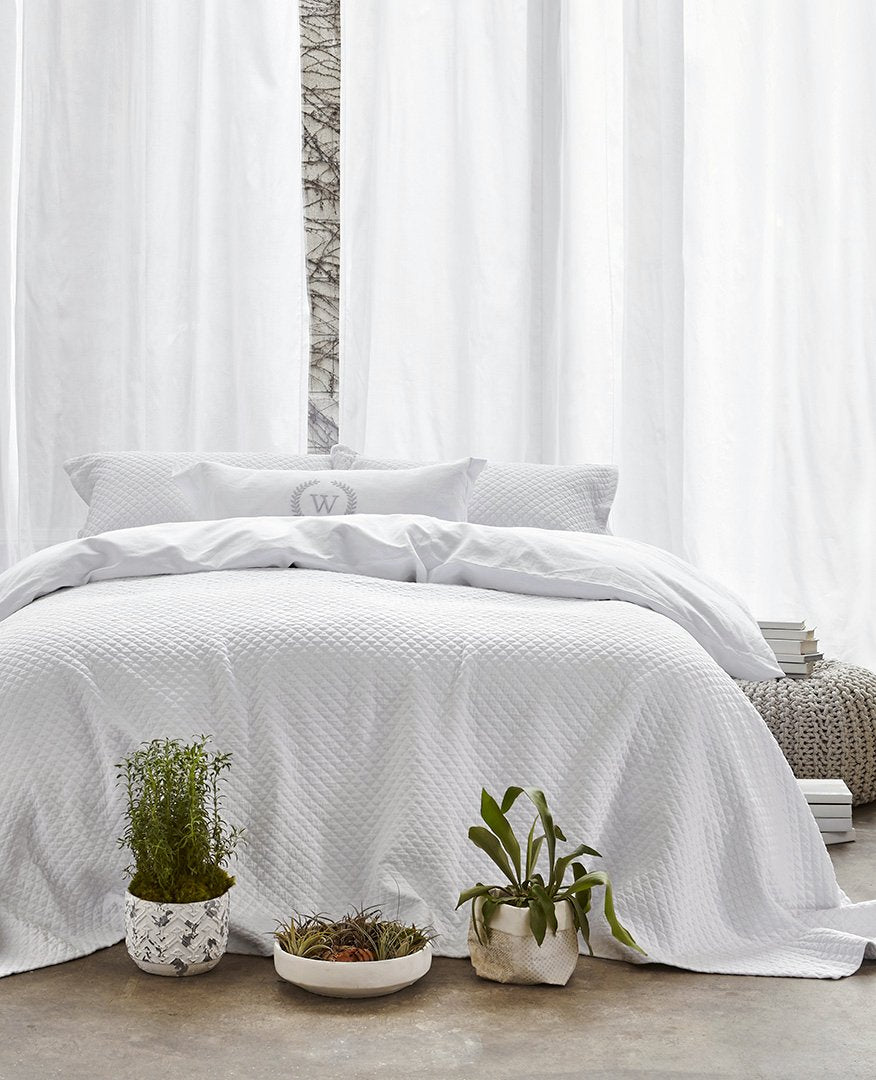![]()
The sun is shining, plants are growing, and everyone is anxious to welcome spring. Gone are the days of cozying up by the fire with a warm blanket, replaced by those spent with windows open and birds singing. Our homes start to feel stuffy around this time of year - motivating many to make space indoors, including clothing and linen closets. But what happens to your once loved textiles after they've left your home?
According to Alternatives Journal, textile waste accounts for more than 5% of a single community's landfill, over 500,000 tonnes every year in Ontario alone! It can take up to 40 years for these textiles to decompose, releasing methane (a dominant greenhouse gas) and leaking dyes and toxic chemicals into the surrounding soil and watersheds along the way.
The following steps will help you sustain the life of your linens, without hurting the environment:
1st: Invest in Excellent Quality Bedding
When it comes to bedding, natural fibres (including cotton, linen, silk, wool, and down) are king. Natural fibres are those derived from plants and animals whereas synthetic fibres are human-made and often petroleum-based. Our founder, Peggy Byron, wanted to change the way Canadians slept when she opened Boutique Au Lit in Montreal in 1981, the first in Canada to offer cotton sheets instead of treated polyester. These fibres have been used since the start of human civilization and for good reason! Cotton and linen sheeting lasts for several years without decreasing in integrity compared to synthetic, and only get softer with time.
There is also an environmental component necessary in the discussion between natural and synthetic fibres. From seed to sheet there are several times in which the environment is impacted. For example, with natural plant fibres you must look at the seed itself, is genetically-modified? How much water is used in its growth? Are herbicides or pesticides used? Is it chemically-treated? All of these questions pose a potential risk to the surrounding environment, not including the problem of textile waste. According to a study completed by the Made-By Network in 2013, the most sustainable textiles are created from recycled and organic materials, with Conventional Flax (linen) and Conventional Hemp as Class C (within classes A-E).
Flax and hemp are incredibly healthy and sustainable plants as they are grown without the need of heavy chemical herbicides and pesticides and copious amounts of water. Our "bestselling" Lavato Linen line features 50% linen 50% cotton sheeting in various colours. Below is our Lavato Linen Flax, also available in White, Clay, and Skylight.
2nd: Use a Safer Laundry Soap
Everyday household detergents often contain bleaching-agents that can not only affect local watersheds but are also carcinogenic to ourselves. Nutrients including phosphates, magnesium, and calcium contribute to eutrophication, the growth of algae and other intrusive plant life. So, stay away from highly fragranced detergents - these may make your linens smell fresh for days, but the health cost to humans and planet is much more substantial.
Try our Fragrance Free Linen Wash from Le Blanc! It's 100% biodegradable, contains organic ingredients, made in USA, and is not tested on animals. Plus this detergent is highly concentrated so you only need a tiny amount per wash.
Le Blanc Fragrance Free Linen Wash
3rd: Wash Better
Unless you're dealing with heavy stains or a recent household flu, use tap cold water when washing. Not only will this keep your Cotton Satins silkier and Percales crisper, it will also reduce electricity use dramatically. When washing whites, skip the bleach and add some baking soda during the washing cycle or pre-soak with 1/2 cup of organic white vinegar.
With softening, avoid fabric softener altogether! Washing your linens naturally should help them last longer and retain their integrity. Fabric softener often contains carcinogens and quats (asthma-inducing) that can break down your fibres while being harmful to humans as well. These toxins wash into local watersheds, destroying wildlife habitat and contaminating drinking water. If you're craving extra softness, add 1/2 a cup of organic white vinegar to your rinsing cycle. I'm sure you can see the pattern with using household products in replace of traditional laundry products, safer for the environment and your health.
4th: Dry Better

As you probably know, the dryer is not particularly friendly to natural fibres nor to your hydro bill! Once the warm summer days arrive you can try hanging your sheets outside for some much appreciated sun-bathing. This may also help with natural bleaching in whites and will make your sheets smell fresh like the outdoors (mmm we can't wait for Spring). In the cooler months, ditch the toxic single-use dryer sheets and replace with wool dryer balls (works as a natural softener too), remove from the dryer while still slightly damp and lay flat or hang to dry in your home.
*Tip: Toss in a couple of tennis balls to reduce overall drying time and wrinkles!
5th: Give it a New Life
There comes a time in the life of your linens when you no longer have a need for them, but then what?
95% of textiles can be recycled somehow to avoid being dumped in landfills. Close the textile loop by donating to a local non-profit, upcycling into something new (a flat sheet can become a great body pillow or a kid’s play tent!), or recycling into industrial rags through a Textile Waste Diversion bin.
Excellent quality sheeting can last several lifetimes if you spend some time getting creative, the planet will thank you!

(via Jute Interior Design)
Guest post from our in-house environmentalist and Online Coordinator, Susan Parkin.






